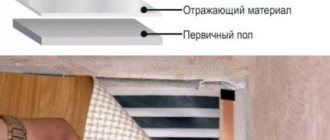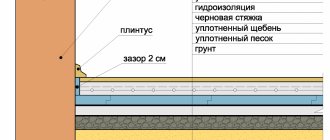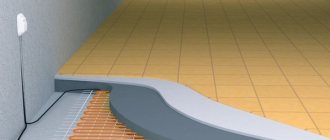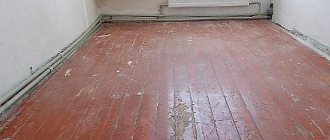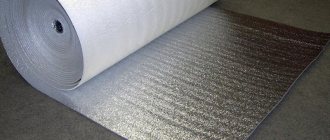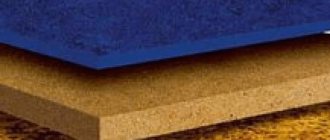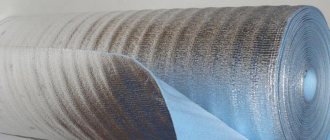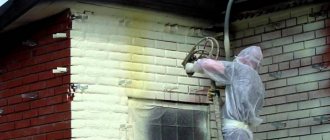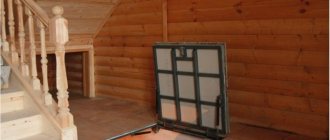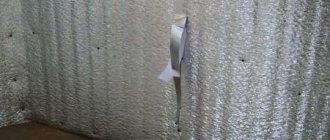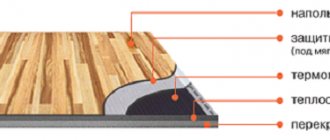One of the most popular floor coverings is linoleum. The big advantage of this material is the huge variety of textures and colors. Not long ago, insulated samples with a dense base appeared on sale. In this article we will try to figure out what they are, what their advantages are and whether there are any disadvantages.
Insulated linoleum
Properties of linoleum
Linoleum with a dense base consists of 5 layers.
- A protective coating that protects against abrasion and mechanical stress.
- Decorative. It looks like a film decorated with ornaments.
- The third layer is made of polyvinyl chloride. Thanks to it, the coating is soft and has the ability to insulate sounds.
- Fiberglass. It provides the coating with strength.
- Insulation. Of all the layers, it is the thickest. It is this that allows the material to provide thermal insulation.
After it there may be a finishing layer, which is a film. It may display the manufacturer's mark. But this layer comes separately from linoleum, the base of which consists of felt.
Insulated linoleum consists of five layers
Types of linoleum
Regardless of its base, linoleum can come in several varieties.
| View | Description |
| Domestic | This type is intended for residential premises where there are no large crowds of people. Since this is the most economical option, its surface has a fairly simple color, which weakly imitates high-quality expensive coatings. Household linoleum is quite soft, and it can be laid in a room located on the ground floor or in a country house. |
| Semi-commercial | This variety can withstand increased loads, so it can be used for installation both in residential premises and in offices. If the room has a very cold floor, then this type of coating can eliminate this problem, but provided that there are not many people there. The colors of linoleum are often the same as those of tiles or parquet, but there are also quite interesting patterns or ornaments. |
| Commercial | Commercial insulated linoleum is rarely found on sale. It is rarely purchased, since in work areas where this material is used, people wear shoes, which allows them to keep their feet warm without insulated linoleum. |
There are several types of linoleum
There is another, rather original type of linoleum called “homogeneous”. This variety has a polyvinyl chloride base mixed with a variety of dyes. The peculiarity of such linoleum is associated with its structure. Thanks to it, the material, even after being used, does not lose its decorative appearance. This is due to the fact that the material is painted throughout its entire thickness and abrasion of the surface does not affect the design in any way. This type of coating can also be made on an insulated base. It is perfect for classrooms in educational institutions.
homogeneous linoleum
Another type is a material that is unable to conduct electrostatic voltage. It is used for rooms where there is a large accumulation of electrical equipment. The outer layer of the material is an insulator from electric current, since it is not capable of conducting it. However, it contains copper strips that are connected to grounding. They are necessary in order to remove static electricity collected by the floor.
Everyone knows that linoleum is a very slippery coating, especially when wet. It is easy to slip on it even in socks. In this regard, manufacturers have developed a coating that has an anti-slip effect. This flooring material is ideal for children's rooms. In addition to having a soft base, it will prevent children from slipping on slippery floors.
You can buy linoleum with an antistatic effect, anti-slip, natural - there are a lot of options
Consumers are accustomed to thinking that linoleum is a completely synthesized material. However, thanks to the latest technologies, manufacturers create natural material with an insulated base based on resins of natural origin. Such a coating would be a good solution even for an eco-house, as it is harmless to health and does not cause allergies. However, the prices for such coverage are also not low.
The process of laying linoleum with pile
This type of coating requires specific attention. It should be noted that choosing linoleum is a simple matter, because they choose it for a long period of time. The material has a two-cavity structure, which affects the characteristics of linoleum and its performance.
Linoleum with pile is perfect for those who love warmth, comfort and coziness: it is soft, elastic and easy to cover the floor surface with.
But it is worth noting that this material can only be laid in a dry room, since moisture can destroy the structure of linoleum and render it unusable. If the floor experiences heavy loads, it is likely that linoleum with pile may not withstand it. Therefore, before purchasing, it is important to take into account all the nuances and characteristics of the room in which linoleum is to be laid.
Laying linoleum is not difficult, the main thing is to approach this process correctly
How to prepare the floor:
- Remove old coating. Assess the condition of the floor without it. The finish must be good, otherwise repair work will need to be carried out.
- Lay a substrate that will serve as a transition layer. It is better to choose the jute option - it has a natural base.
- Covering the floor with plywood sheets will give the surface strength.
- Carry out waterproofing if the floor is covered with wood. To do this, put a film on it. Cover it with fiberboard, prime it, and cover it again with film.
Related article: DIY cat playhouse with scratching post
The film floor is laid on top of this entire floor structure. Experts do not advise laying chipboard under linoleum - this is a rather fragile material that can lead to the failure of the floor. Linoleum with pile is perfect for dry living spaces with normal humidity levels.
Types of insulation
In addition to the top layer, linoleum also differs in the type of insulation used in the manufacture of this floor covering. Various materials can be used for thermal insulation.
Insulated types of linoleum are produced with different parameters. The dimensions in this case are not only set by the wishes of the manufacturer, but also depend on the type of substrate. Each manufacturer produces any type of linoleum with a minimum width of 1.5 meters. Next, the width continues to increase by 50 cm.
The width of the foam-based material is 5 meters. Such parameters are in great demand, as they are convenient for installation in apartments with a standard layout. In this case, there is usually no need to resort to joining or gluing the canvases.
Felt material is manufactured with a maximum width of 3 meters.
Insulated linoleum can be felt, foam-based, jute
The natural covering with a jute backing is quite brittle, so it will have a width of no more than 2.5 meters.
The maximum roll length can be 60 meters, but usually their length does not exceed 15-45 meters. Due to its fragility, natural canvas cannot be longer than 6 meters.
To select the parameters of insulated linoleum for your home, you need to measure the perimeter of the room. Due to the fact that when building a house and renovating, the parameters of a regular rectangle are very often violated, it is necessary to take careful measurements of all four sides.
You need to add another 5 cm to the resulting length and width. This way you can get a canvas size that is suitable for the floor in a given room.
Since the width of the linoleum is predetermined and there is no point in cutting it, you need to choose the optimal size. For example, if a room of 3 * 3.9 m requires a canvas with parameters of 3.05 * 3.95 m, this canvas will have to be cut to a minimum. This way some of the money will be saved.
insulated linoleum
It is important to take measurements of the room in advance in order to buy enough material
Installation
Linoleum is laid using the classic method.
Installation work in the case of PVC coatings with a heat-insulating base is not fundamentally different from similar work using conventional linoleum. The roll is brought to the site, they wait until the material acclimatizes.
Then it is cut according to the size of the rooms and the accepted floor pattern. The resulting pieces are then laid out on the floor, leveled and fixed in the desired position using glue or double-sided tape. You can get by by simply pressing the coating along the edges with baseboards.
Linoleum is cut and rolled out on the floor.
For high-quality joining, the sheets are laid on the floor with the pattern up and a slight overlap is made. By shifting the sheets relative to each other, the pattern is matched, they are pressed with a ruler and a cut is made under it through both layers of coating, obtaining an even cut that perfectly matches the mating edge of the other sheet.
The edges of the joined sheets are fixed with tape.
Next, the edges of the sheets are fixed to the floor at the junction with double-sided tape, after which the seam is filled with a compound for cold chemical welding of PVC. After the glue has dried, the excess is cut off from the seam with a sharp knife. Finally, the baseboards are installed, after which the installation can be considered complete.
Selection criteria
When choosing any type of linoleum, you need to take into account the general classification in order to purchase a coating that meets all the criteria. It is worth considering the wear resistance class:
- household – from 21 to 23;
- for public places – from 31 to 43;
- for industrial use - from 41 to 43.
There is a division into the following groups:
- F – the smallest thickness, including wear resistance;
- M – low level of wear resistance;
- N – average level of wear resistance;
- T is the most wear-resistant type.
When purchasing, be sure to pay attention to the wear resistance class of linoleum
Criteria for choosing a coating on a foam layer
When choosing linoleum on a foam base, you need to take into account that such a coating is similar in structure to a multi-layer cake - this explains its thickness. In order for the coating to fit into the interior, it must be consistent in color and design with the room. You can avoid problems with laying the flooring by laying it in the room where it will be laid.
This surface is very practical, since even with prolonged use it does not wear off, due to the fact that the pattern passes through the entire structure of the material. This allows it to be used for rooms intended for heavy loads.
Foam-based linoleum is quite popular and inexpensive.
Choosing linoleum with a natural base
This type of linoleum is good for rooms with little traffic, such as a bedroom. But this natural coating requires selection taking into account the criteria for use, because mechanical damage forms on it very quickly. However, this type of linoleum cannot be exposed to high humidity, otherwise the natural base will begin to rot.
Natural insulated linoleum does not really like high humidity, so it should not be used in the kitchen or bathroom
General recommendations for selection
Such a thick floor covering can create comfortable conditions for living indoors if the choice was made correctly. Among the main conditions, the following can be noted.
- If the humidity level in the room is high, then it is better to refuse a two-layer felt or jute covering.
- For high traffic indoors, the best choice is linoleum on a foam base.
- When purchasing linoleum for several rooms at once, you need to take into account the combination of color and style.
- When connecting individual fragments of the coating, you need to ensure a clear connection of the pattern.
- Correct selection of parameters will reduce the number of seams and joints on the floor covering.
If you make the calculations correctly in advance, you can avoid a large number of joints - For each individual room you need to choose linoleum with suitable wear resistance. For example, a pantry or bathroom does not require a very durable coating.
- For the lower floors of private or apartment buildings you need to purchase linoleum on a foam base.
- A two-layer surface on a natural surface does not need to be fixed to the floor, because this has a bad effect on the thermal insulation of the material.
- For children's rooms, it is better to choose jute linoleum - it is very comfortable and safe for children.
For children's rooms, it is better to choose natural linoleum, for example, jute or felt.
Read more about the pros and cons of types of substrates.
Jute and linen
Both options for a jute and linen base for linoleum can be considered if ecology and safety are a priority. The beneficial qualities and disadvantages of these materials are similar.
Pros:
- antibacterial properties;
- absence of foreign odors;
- beneficial effect on the indoor microclimate;
- good heat and sound insulation;
- hygroscopicity;
- ability to withstand heavy loads;
- service life is several times longer than that of polymer materials;
Flaws:
- the material has a memory for long-term point exposure to heavy objects;
- the cost is higher than that of polymer substrates.
Attention! To reduce the shock-absorbing effect and movement of linoleum, the jute lining should be no thicker than 5 mm.
Cork
The choice of this lining material for linoleum is justified if the goal is to give the flooring greater rigidity.
Pros of cork:
- environmental friendliness;
- good sound insulation;
- durability;
- smoothing out concrete screed errors;
High thermal insulation characteristics give cork a useful quality as insulation.
Thermal insulation from cork under linoleum
Some weaknesses:
- not suitable for laying under linoleum on a warm floor - high resistance to heat transfer;
- cork can collapse under prolonged static loads, for example from furniture;
- low leveling ability, a floor difference of more than 2 mm on a 2-meter segment is already critical.
- is afraid of high humidity, which limits its use in rooms without good waterproofing of the base.
Conclusion - cork backing is well suited for children's rooms and bedrooms, if the rather high price does not scare you.
Coniferous
Advantages of coniferous material:
- long service life - 15-20 years;
- good insulation;
- due to the high density, all defects of the subfloor are hidden;
- withstands dynamic and static loads;
- good sound insulation.
Cons: high cost.
Installation technology requires skill and accuracy.
Installation of coniferous underlayment
Most user reviews indicate that, from an environmental point of view, the optimal option for using coniferous underlayment under linoleum.
Felt
Felt substrates, both natural and synthetic, have good performance qualities:
- low thermal conductivity;
- abrasion resistance;
- antibacterial properties;
- light weight.
The disadvantage is the softness of the material. Therefore, such a gasket is rarely used with linoleum.
You can give preference to felt if you like to walk on soft floors, in children's rooms and in rooms where there is no massive furniture.
Combined
Combined substrates are practical for use under linoleum covering.
Combined lining
Advantages:
- high-quality insulation;
- wear resistance.
Minuses:
- poor ventilation;
- ability to slip through.
Attention! Substrates with a combination of bitumen cannot be used in rooms with elevated temperatures - foreign odors may appear.
The high density of the material justifies the use of combined underlays for floor insulation and sound insulation.
Polymer
There are a lot of offers of polymer materials, including PET, on the market.
Pros:
- high degree of fire protection;
- good waterproofing.
Flaws:
- relatively short service life;
- caking and loss of original shape;
- decrease in depreciation over time;
- low leveling ability.
In addition, the airtightness of polymer materials makes wooden floors vulnerable to fungus and damage.
Also pay attention there is an article on the topic “Underlay on a wooden floor under linoleum”, read more at the link
Rotting of wood due to the waterproofness of the substrate
Despite the existing disadvantages, the popularity of polymer substrates is great and this is due, first of all, to the low price and ease of installation.
Foil
A layer of aluminum foil gives linoleum additional advantages:
- increase in service life;
- increased sound absorption;
- protection against fungus;
- steam and waterproofing;
A significant advantage of the foil lining is the reflection of heat into the room. Research suggests that this figure can be from 30 to 90%
The choice of foil is largely justified when laying it under linoleum on a warm floor.
Please note there is an article on the topic “linoleum for heated floors: how and which one to choose”
Foil backing for heated floors under linoleum
The waterproofing properties of foil are used when finishing floors in rooms with high humidity - in bathrooms, bathrooms, kitchens, as well as in rooms located above basement unheated rooms.
Composite substrate
One of the advantages of the composite material is that when installing on a concrete screed, there is no need to lay additional polyethylene film.
Please also note there is an article on the topic “substrate for a concrete floor under linoleum”, read more at the link
Other advantages:
- elasticity;
- leveling out unevenness and potholes in the subfloor;
- good waterproofing;
- prevents floor rotting processes;
- withstands heavy loads;
- long service life.
The downside is the high price.
The use of this type of gasket under linoleum has no significant restrictions and depends mainly on capabilities and preferences.
Composite backing is a good option for linoleum
General advice and conclusion
When choosing a substrate, it is necessary to take into account the type of linoleum, the base on which it is laid and the operating conditions.
General tips:
- A universal option, compatible with all coatings, including linoleum, is cork backing.
- It is advisable to use synthetic substrates in rooms with little traffic.
- In rooms with high humidity, natural cushioning material without impregnation or waterproofing should be used with caution.
- Under commercial linoleum, you can put an additional layer of flax; under semi-commercial linoleum, it is advisable to lay a denser one - jute.
- In a heated floor system, it would be correct to use foil material.
- With household linoleums of low wear resistance, it is better to use jute or cork substrates.
Practical experience and user videos show that with any type of linoleum, with or without a base, the use of a backing is necessary. This insulating material will add additional comfort to the floor and make it more durable.
Features of laying felt linoleum
Pile coverings require special attention. It is worth noting that selecting linoleum is not an easy task, because it will be used for a long time. Linoleum has a structure consisting of two cavities: they will determine the properties of linoleum and its performance characteristics.
About felt linoleum
Felt linoleum will be appreciated by people who prefer convenience, coziness and warmth. It has elasticity, softness, and is easy to lay.
However, only a dry room is suitable for using such material, otherwise moisture will destroy the coating from the inside and make it unfit for use. But if the floor covering is subject to heavy loads, most likely, a covering with a fleecy surface will not be able to withstand it. Thus, before purchasing linoleum, you need to take into account all the features of the room in which you plan to install it.
It is better not to use felt linoleum in high-traffic areas
Laying linoleum will not be a problem if you approach this task responsibly and take into account the recommendations of specialists.
↑ Insulated linoleum
Insulated linoleum based on jute or felt cannot be laid in rooms with high humidity
This flooring is the most affordable and simple. The material itself is two-layer, consisting of a base and a working surface. Jute or felt is usually used as a base, and the working surface is made of PVC film. This linoleum is quite soft, elastic, easy and quick to install using both glue and non-glue methods. Has good thermal insulation characteristics.
Unfortunately, such linoleum has more disadvantages than advantages. Firstly, the working surface has an insufficient level of strength, is easily damaged and requires careful operating conditions. Secondly, jute or felt-based linoleum quickly loses its performance characteristics in high-traffic areas. The base quickly becomes thinner, which negates its thermal insulation characteristics. Thirdly, due to the use of jute and felt in the base, it is highly not recommended to lay insulated linoleum in rooms with high humidity or on a base that has poor waterproofing. The reason is quite simple - the base is made of natural materials that do not tolerate moisture well and are quickly destroyed under its influence. And over time, fungi and mold begin to appear under the working surface instead of felt. Currently, insulated linoleum on a jute or felt base has practically disappeared from the market, and it has been replaced by linoleum with a multi-layer warm base.
Floor preparation
First you need to remove the previous covering and evaluate the subfloor. If it is of poor quality, various defects and irregularities must be eliminated.
Then you need to roll out the substrate, which acts as a transition layer. The best option is a jute base, it is the safest.
First, remove the old floor covering, then lay the underlay under the linoleum
To increase the strength of the floor, it is covered with plywood sheets.
If the floor surface is wooden, it is worth providing waterproofing. This can be done by laying down a film, then covering it with fiberboard sheets, then priming them and covering them with another layer of film.
Professionals do not recommend placing chipboard sheets under linoleum, as this is a fragile material that can be deformed.
Bonding linoleum joints - analysis of methods
When buying linoleum, you should pay attention to its width. It's good if it matches the width of the room. In this case, it will be possible to lay linoleum without connecting the joints. Thus, the base will acquire an optimal level of sound and heat insulation, as well as tightness.
In a situation where linoleum has already been purchased, but its width does not correspond to the width of the room, the seams will need to be glued. This technology is suitable for both foam-based linoleum and warm varieties.
Welding of joints can be carried out using two methods: hot or cold. The latter can be done using a tube of glue containing tetrahydrofuran, plasticizers and chlorine.
cold welding for linoleum
Linoleum joints can be joined by cold or hot welding
The hot method involves the use of a hair dryer and wire, which must melt under high temperature. The resulting liquid mixture should fill the joints to create a tight and impermeable joint. This method is the best, but its implementation requires special equipment and skill in working with them.
The gluing procedure must be performed very carefully so that the melted glue does not drip onto the linoleum.
Before purchasing linoleum, you need to obtain information from the seller about how it can be joined. Many types of household coating cannot be hot glued, because the soft coating is not suitable for high temperatures.
Experts recommend using cold welding for residential premises
To perform cold welding you will need a ruler, masking tape, a welding tube, and a knife with a sharp blade. Let us describe the sequence of actions.
| Sequencing | Description |
| Linoleum is laid joint to joint. In this case, you need to ensure that the connection of the canvases is very tight and the pattern matches. After this, the joints are connected using masking tape. For high-quality gluing, the seam should run through the center of the tape. Then an incision is made through the tape at the joint. |
| Before applying the mixture, you need to carefully read the instructions. After opening the tube, a special needle is attached to it and placed into the incision. The joints are then filled by welding along the entire length of the seam. |
| The gluing process must be carried out very carefully. If welding gets on an uncovered sheet, it will be difficult to remove it without damaging the surface. After 10 or 15 minutes, the masking tape can be removed. The welding will dry completely only after 2-3 hours. |
The hot method is more complex. To perform this, you will need to purchase a welding hair dryer with a special nozzle. In this case, instead of glue, you will need a special wire, which has a similar composition to linoleum.
When performing the work, in addition to the equipment, you will need a knife with a sharp blade and a vacuum cleaner in order to collect the remaining debris.
welding hair dryer
| Sequencing | Description |
| Once the quality of the joining and alignment of the pattern has been assessed, it will be possible to trim the seam to a chamfer. Both a construction knife and a curved knife designed for joining are suitable for this. After this, you will need to collect all the garbage. The joints between the panels must be thoroughly cleaned with a vacuum cleaner. |
| To operate, a hair dryer is heated to a temperature of 350 or 400 degrees. Then a nozzle is put on it and the wire is inserted. Carry out the first burning of the wire. |
| After this, you can begin gluing the seams. The joints are filled with the compound along the entire length. |
| When the seam dries, its remains are cut off with a knife. Special blades are sold for this. First, the most protruding part of the weld is cut off, and then the final trim is made flush with the felt surface. |
Do-it-yourself welding of linoleum
Gluing seams using cold welding
At home, it is impossible to join individual sheets of material using the hot method, which is considered the best in terms of strength and tightness. Home craftsmen can only cold weld linoleum on a felt base, which involves the use of PVC-based glue, plasticizers and tetrahydrofuran.
The product is produced in the form of a tube with a thin needle, from which, when pressed, the linoleum glue itself is supplied. Since it contains chlorine, the edges of the joining parts dissolve, and the frozen seam comes out smooth, even and almost invisible.
Independent gluing of linoleum on a felt base using the cold welding method can be done using the following types of glue:
Fabric-based linoleum: which base is better?
- For new and hard surfaces. This composition is very liquid, leaves no traces after “welding”, and eliminates even minimal gaps;
- For repairing old material that has come apart at the seams, burst or been cut during use. This glue is much thicker than the previous one, tightly fastens seams up to 5 mm wide, and its excess can be easily scraped off with a stationery knife;
- Professional, made for PVC linoleum on a felt-polyester base. Absolutely transparent and provides an elastic joint.
Famous manufacturers
Insulated linoleum from several companies is sold in the markets of our country. Let's list the most popular ones.
Tarkett
This manufacturer is a leader among companies involved in the creation of flooring. It has been producing a wide variety of flooring surfaces since the beginning of the 20th century. The quality of the product meets not only domestic sanitary standards, but also European ones. The company produces both felt-based and foam-based products. In addition, all material has a high fire safety class.
Linoleum Tarkett
IVC
This manufacturer produces its products in Belgium. His product has excellent characteristics and a unique design, so a room with such a floor looks very chic. Thermal insulation is provided in this case by felt. Therefore, the surface will not only be soft and warm, but you can also walk on it barefoot.
Linoleum IVC
Forbo
This company specializes in the production of eco-linoleum. Its products contain about 97% natural ingredients. One of the company's lines creates a cork-based coating. It not only perfectly prevents heat loss, but also blocks sounds. Other lines use jute for thermal insulation.
Linoleum Forbo
"Comitex Lin Parma"
The specialization of this enterprise is to create economy-class household coverings. The insulation in this case is felt. This linoleum is well suited for temporary housing or a summer cottage. Its price allows this.
Linoleum Komitex Lin Parma
Linoleum care
Proper care will allow your floor to always look cozy and beautiful, as well as retain heat. Most users do not consider such measures necessary, but if they are not followed, its surface will quickly become unusable. In addition, all these activities are not labor-intensive:
- regular cleaning of dust and dirt;
- polishing, it will be useful even if the coating is already shiny.
If you do not neglect such manipulations, the coating will please the eye for a long time.
To prevent linoleum from losing its original appearance, it is worth caring for it properly
Which coating is suitable for a cold floor?
The choice of floor covering for thermal insulation is determined by a number of factors. The budget allocated for the purchase of material will play a key role. If its size does not matter, then it is better to opt for natural linoleum. But if the amount intended for the purchase is quite modest, it is worth purchasing a household type of covering or looking in stores for the remains of high-quality linoleum, which is sold at a low price.
The choice of linoleum may be influenced by the purpose of the room for which the renovation is planned. For example, you can choose a household covering for a nursery or bedroom, and buy a semi-commercial covering for the rest of the common rooms.
The base for linoleum is also important. For uneven wooden surfaces, the best option would be a felt-based coating. This recommendation is due to the fact that felt hides gaps between boards and small differences. But for a perfectly flat surface, you can choose any linoleum.
If the surface of the subfloor is perfectly flat, you can choose any type of linoleum
For the bathroom, you should choose linoleum with foam insulation. It is not afraid of the effects of fungi or mold, and also reacts calmly to temperature changes and high humidity.
Layers of linoleum on a foam base
The structure of foam-based linoleum is quite complex. The thickness of linoleum is large enough to provide the surface with heat and make it even. Linoleum with this type of base has a beautiful appearance, which contributes to its popularity among consumers.
One of the well-known types of linoleum, which is widely popular and has high-quality characteristics, is Tarkett.
This is linoleum with a heat-insulating surface, wear-resistant, durable and at the same time breathable. Its base consists of six layers, each of them performs its own function. Linoleum is thinner than felt-based flooring, but the addition of fiberglass makes it much stronger.
Related article: How to make an arch at home yourself
Many people prefer to choose insulated linoleum because it is easy to care for
Foamed linoleum layers:
- Transparent layer for protection;
- Decorative;
- Foam layer;
- Primed layer;
- Bottom foam layer;
- Back layer.
This is the most practical type of flooring. It is easy to care for and wash. It is only important to remember that it is better to clean linoleum every day, and not just once after it becomes impossible to wash it from accumulated dirt and dust.
